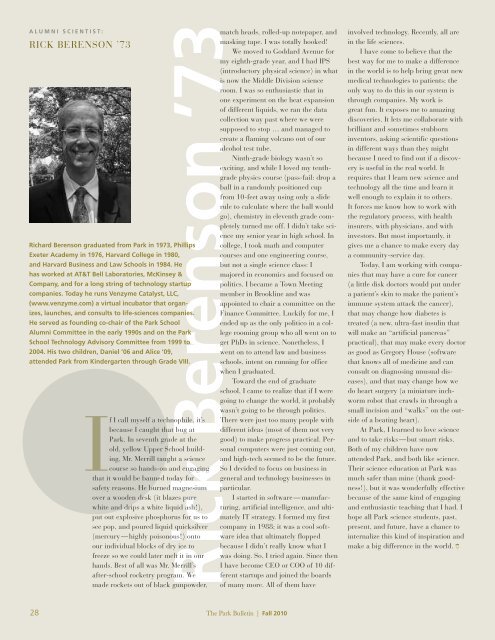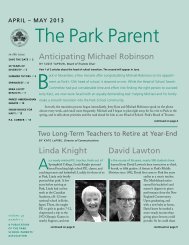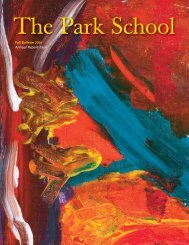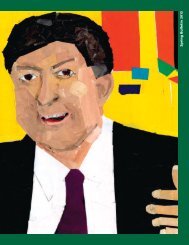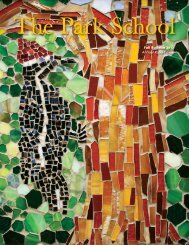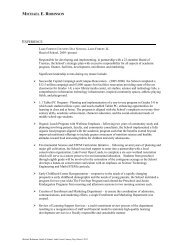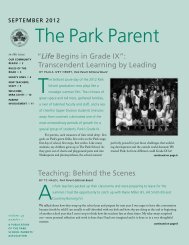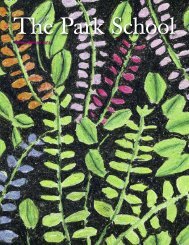⢠ParkBulletinCover - The Park School
⢠ParkBulletinCover - The Park School
⢠ParkBulletinCover - The Park School
- No tags were found...
You also want an ePaper? Increase the reach of your titles
YUMPU automatically turns print PDFs into web optimized ePapers that Google loves.
A L U M N I S C I E N T I S T :RICK BERENSON ’73Rick Berenson ’73Richard Berenson graduated from <strong>Park</strong> in 1973, PhillipsExeter Academy in 1976, Harvard College in 1980,and Harvard Business and Law <strong>School</strong>s in 1984. Hehas worked at AT&T Bell Laboratories, McKinsey &Company, and for a long string of technology startupcompanies. Today he runs Venzyme Catalyst, LLC,(www.venzyme.com) a virtual incubator that organizes,launches, and consults to life-sciences companies.He served as founding co-chair of the <strong>Park</strong> <strong>School</strong>Alumni Committee in the early 1990s and on the <strong>Park</strong><strong>School</strong> Technology Advisory Committee from 1999 to2004. His two children, Daniel ’06 and Alice ’09,attended <strong>Park</strong> from Kindergarten through Grade VIII.If I call myself a technophile, it’sbecause I caught that bug at<strong>Park</strong>. In seventh grade at theold, yellow Upper <strong>School</strong> building,Mr. Merrill taught a sciencecourse so hands-on and engagingthat it would be banned today forsafety reasons. He burned magnesiumover a wooden desk (it blazes purewhite and drips a white liquid ash!),put out explosive phosphorus for us tosee pop, and poured liquid quicksilver(mercury—highly poisonous!) ontoour individual blocks of dry ice tofreeze so we could later melt it in ourhands. Best of all was Mr. Merrill’safter-school rocketry program. Wemade rockets out of black gunpowder,match heads, rolled-up notepaper, andmasking tape. I was totally hooked!We moved to Goddard Avenue formy eighth-grade year, and I had IPS(introductory physical science) in whatis now the Middle Division scienceroom. I was so enthusiastic that inone experiment on the heat expansionof different liquids, we ran the datacollection way past where we weresupposed to stop … and managed tocreate a flaming volcano out of ouralcohol test tube.Ninth-grade biology wasn’t soexciting, and while I loved my tenthgradephysics course (pass-fail: drop aball in a randomly positioned cupfrom 10-feet away using only a sliderule to calculate where the ball wouldgo), chemistry in eleventh grade completelyturned me off. I didn’t take sciencemy senior year in high school. Incollege, I took math and computercourses and one engineering course,but not a single science class: Imajored in economics and focused onpolitics. I became a Town Meetingmember in Brookline and wasappointed to chair a committee on theFinance Committee. Luckily for me, Iended up as the only politico in a collegerooming group who all went on toget PhDs in science. Nonetheless, Iwent on to attend law and businessschools, intent on running for officewhen I graduated.Toward the end of graduateschool, I came to realize that if I weregoing to change the world, it probablywasn’t going to be through politics.<strong>The</strong>re were just too many people withdifferent ideas (most of them not verygood) to make progress practical. Personalcomputers were just coming out,and high-tech seemed to be the future.So I decided to focus on business ingeneral and technology businesses inparticular.I started in software —manufacturing,artificial intelligence, and ultimatelyIT strategy. I formed my firstcompany in 1988; it was a cool softwareidea that ultimately floppedbecause I didn’t really know what Iwas doing. So, I tried again. Since thenI have become CEO or COO of 10 differentstartups and joined the boardsof many more. All of them haveinvolved technology. Recently, all arein the life sciences.I have come to believe that thebest way for me to make a differencein the world is to help bring great newmedical technologies to patients; theonly way to do this in our system isthrough companies. My work isgreat fun. It exposes me to amazingdiscoveries. It lets me collaborate withbrilliant and sometimes stubborninventors, asking scientific questionsin different ways than they mightbecause I need to find out if a discoveryis useful in the real world. Itrequires that I learn new science andtechnology all the time and learn itwell enough to explain it to others.It forces me know how to work withthe regulatory process, with healthinsurers, with physicians, and withinvestors. But most importantly, itgives me a chance to make every daya community-service day.Today, I am working with companiesthat may have a cure for cancer(a little disk doctors would put undera patient’s skin to make the patient’simmune system attack the cancer),that may change how diabetes istreated (a new, ultra-fast insulin thatwill make an “artificial pancreas”practical), that may make every doctoras good as Gregory House (softwarethat knows all of medicine and canconsult on diagnosing unusual diseases),and that may change how wedo heart surgery (a miniature inchwormrobot that crawls in through asmall incision and “walks” on the outsideof a beating heart).At <strong>Park</strong>, I learned to love scienceand to take risks—but smart risks.Both of my children have nowattended <strong>Park</strong>, and both like science.<strong>The</strong>ir science education at <strong>Park</strong> wasmuch safer than mine (thank goodness!),but it was wonderfully effectivebecause of the same kind of engagingand enthusiastic teaching that I had. Ihope all <strong>Park</strong> science students, past,present, and future, have a chance tointernalize this kind of inspiration andmake a big difference in the world.28 <strong>The</strong> <strong>Park</strong> Bulletin | Fall 2010


